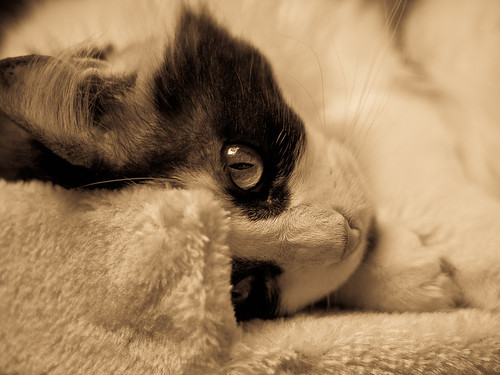Classic Lenses
 |
| "Lucy in her cat tree" Olympus E-P2 with OM 50mm 1:1.4 1/100s, f/2, ISO 400, Manual |
 |
| "Peek-a-boo" Olympus E-P2 with OM 50mm 1:1.4 1/320s, f/2.8, ISO 400, -0.3 EV |
We spend too much money re-buying lenses. I will grant you that the art and science of optics as applied to photography has advanced from a technical perspective over the last 30 years, at least on paper. Extra low dispersion glass that does a better job of focusing all wavelengths of light to the same point on a sensor and manufacturing techniques that make it easier, if not cheaper, to create aspherical elements have helped to create lenses that are, under certain circumstances, clearly superior to older lenses from the "film age".
And unfortunately at considerable cost.
Unless you've dropped considerable cash on a large sensor camera body (135mm frame size or higher), and invested considerable time learning the best techniques for achieving the potential such a system is supposed to achieve, then you're wasting your time and money, especially when there are so many older lenses with excellent characteristics on the market ranging in cost from very affordable to free.
 |
| "OM 50mm on E-P2" Olympus E-3 with Zuiko Digital 50mm 1:2 1/100s, f/4.5, ISO 100 |
I've learned to appreciate the use of old OM Zuiko film lenses on my FourThird and µ FourThird bodies. There are any number of reasons why I reach for the OM 50 1:1.4. The one key reason I keep going to it is that it's a manual focus lens. Regardless of the body, no matter how quickly a lens automatically focuses when you trip the shutter, it will always be slower than a lens that does not. In tricky lighting I would rather set the focus one time, then wait for the right moment (or moments) to trip the shutter and have a better chance of recording what I want. And trust me; if you've got a Pen, then you know how notoriously slow focusing they can become under low light.
Yet, in spite of that, I love that camera for what it can and does do for me.
The other reason is size. It's not just Olympus, it's all the manufacturers. Newer fast primes that autofocus are larger and heavier than their older manual equivalents. That OM 50mm mounted on the E-P2 above is still smaller than the Zuiko Digital 50mm macro used to make the photograph. And the OM is a full stop faster than the ZD.
Older, manual lenses will show their age under harsh circumstances. There are times when you need the automatic lens mated to the digital body, and experience will quickly teach you this. But there are numerous circumstances when an older manual lens in good condition is preferable. Part of the delight of photography is finding out which lenses, and those circumstances.

Comments
Post a Comment
All comments are checked. Comment SPAM will be blocked and deleted.